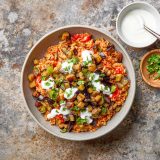For Rawia Bishara, the flavor of childhood summers was shulbato, a Palestinian bulgur pilaf tinted red from just-picked tomatoes. And in her father’s village north of Nazareth, the best shulbato was made using the first wheat of the season.
Most of the wheat was parboiled, dried and cracked to create bulgur to store for the year. But her mother would use up any extra to make shulbato, combining it with cumin, caramelized onions, eggplant and crisp green peppers.
“You have all this stuff growing in the garden,” says Bishara, author of the cookbook “Levant.” “And your wheat is ready to put away for the whole year, but it’s still fresh.” Later in the year, they would bring the dish to fuel them while picking olives in her mother’s village. “For me, these are the memories tied to shulbato.”
The memories resonate still, as shulbato is a menu mainstay at Tanoreen, the Brooklyn restaurant where Bishara has worked six, even seven days a week since she opened in 1998. It’s still one of her favorite dishes.
It’s easy to see why. The recipe is simple, but the flavors are anything but. And it’s delicious even made with store-bought bulgur and a what-have-you assortment of summer vegetables. In less than half an hour, it comes out wholesome, filling and fresh.
The cooking technique is similar to the rice pilafs served from India to the Balkans: The grains are cooked briefly with aromatics before adding liquid. But in much of the Middle East, a pilaf may instead be made with bulgur, and in Palestinian cuisine, that bulgur pilaf most often is shulbato.
Some people cook the vegetables and bulgur together, but Bishara insists on preparing them separately to maintain the distinct flavors and textures of each ingredient. Cooking separately also ensures a lighter, fluffier pilaf. For our version, we agreed; eggplant, cubanelle peppers and cherry tomatoes are cooked separately while the bulgur rests, then mixed in later.
In the meantime, we broke a couple of our own rules about tomato paste and bulgur so we could highlight the bright flavors in this summery dish. Typically, we recommend deeply browning tomato paste to enrich its flavor. But in this case, we preferred the brighter, more acidic flavors of only slightly cooked paste. We also normally toast bulgur to deepen its flavor, but here we prefer not to, which allows the vegetables to shine more brightly.
Half of the cooked vegetables are mixed into the bulgur, and we layer the rest on top. The nuttiness of the grains comes through, with the tomato as a supporting character. A dollop of cooling yogurt and fresh cilantro enliven the earthy dish. You could almost imagine picking olives.
Bulgur Pilaf with Tomatoes
Albert Stumm
July - August 2023

Get the Recipe
Bulgur Pilaf with Tomatoes and Eggplant (Shulbato)
Tomatoes and peppers sweeten a summery Palestinian pilaf
Photo: Joe Murphy; Styling: Wes Martin






